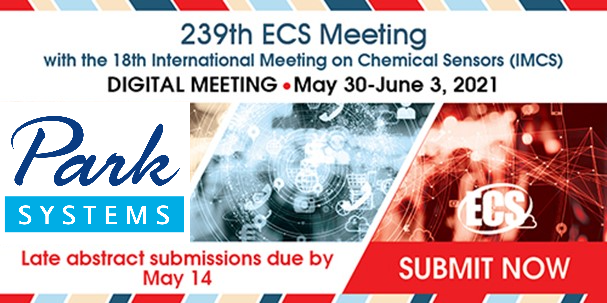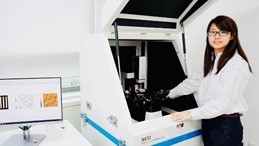
Park Systems is proud to exhibit at the virtual 239th ECS Meeting on May 30-June 3, 2021.

Jiali Zhang, Presenter at the 239th ECS Meeting, Park Systems
The Holy Grail in electrocatalysis and energy storage is to correlate electrochemical activity with nanostructured electrochemical interfaces (electrodes). Park SECCM was developed to addresss this issue.

ABSTRACT:
Scanning Electrochemical Cell Microscopy Based Nanoscale Electrochemistry Study
The objective in electrocatalysis and energy storage is to correlate electrochemical activity with nanostructured electrochemical interfaces (electrodes) [1]. However, it is challenging to quantify the heterogeneity of electrode structures or study the local structure-activity relationship for these interfaces using conventional macroscopic electrochemical techniques. Scanning electrochemical cell microscopy (SECCM) is a new nanoelectrochemical scanning probe technique designed to investigate the local electrochemical properties of electrode surfaces. In this study, the electrochemically reversible [Ru (NH3)6]3+/2+ electron transfer process at a highly ordered pyrolytic graphite (HOPG) surface was recorded with SECCM technique using Park NX12 AFM system. A single barrel glass nanopipette with a Ag/AgCl quasi-reference counter electrode(QRCE) is utilized [2]. Using previous successful experience in commercializing pipette-based electrochemical microscopy [3], Park Systems’s hardware and software enable localized nanoscopic cyclic voltammetry each time the meniscus contacts the surface. The redox process at the HOPG surface is detected with high reproducibility and robustness, with a current limit as minute as a few pA. Position dependence electrochemical current mapping is demonstrated. These results suggest that the effectiveness of Park Systems’s commercial SECCM option for quantitative electroanalysis at the nanoscale. This capability could also facilitate the rational design of functional electromaterials with potential applications in energy storage (battery) studies and corrosion research.
[1] Guell, A. G., Ebejer, N., Snowden, M. E., Macpherson, J. V., & Unwin, P. R. (2012). Structural correlations in heterogeneous electron transfer at monolayer and multilayer graphene electrodes. Journal of the American Chemical Society, 134(17), 7258-7261.
[2]Gao, R., Edwards, M. A., Qiu, Y., Barman, K., & White, H. S. (2020). Visualization of Hydrogen Evolution at Individual Platinum Nanoparticles at a Buried Interface. Journal of the American Chemical Society, 142(19), 8890-8896.
[3] Shi, W., Goo, D., Jung, G., Pascual, G., Kim, B., & Lee, K. Simultaneous Topographical and Electrochemical Mapping using Scanning Ion Conductance Microscopy–Scanning Electrochemical Microscopy (SICM-SECM).
For engineers and researchers that need accurate data on conductance, sample resistance, and other electrical and topographic properties, products like the Park NX 10 offers a range of electrical scanning modes including PinPoint™ Conductive AFM, Conductive Probe AFM, and Electrostatic Force Microscopy.
.
The mission of The Electrochemical Society is to advance theory and practice at the forefront of electrochemical and solid-state science and technology, and allied subjects.
To encourage research, discussion, critical assessment, and dissemination of knowledge in these fields, the Society holds meetings, publishes scientific papers, fosters training and education of scientists and engineers, and cooperates with other organizations to promote science and technology in the public interest.




